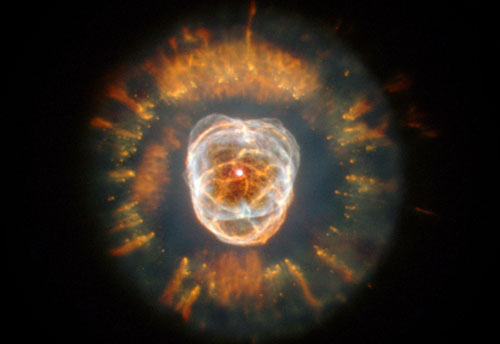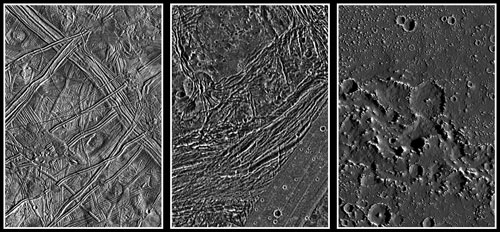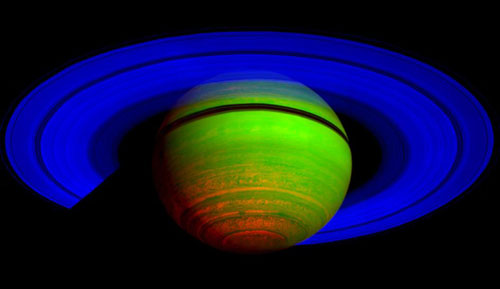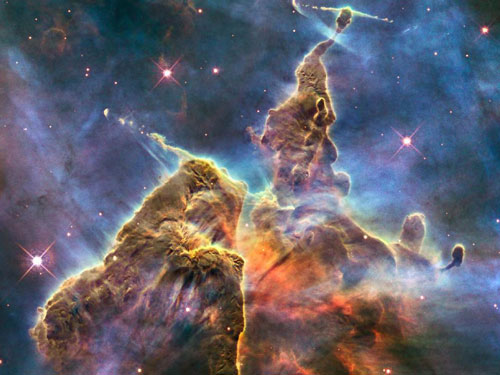By Gail Jacobs
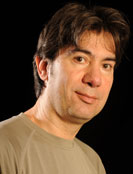 If planets are a dime a dozen, moons are less than a penny each. There are at least 139 moons just within our own solar system. Most of these are the property of the gas giant planets beyond Mars. More than just a nice accompaniment to planets, moons may have habitats in which liquid water could ebb and flow - and possibly be a suitable home for life. Dr. Paul Estrada, a planetary physicist with the SETI Institute, investigates how moons around gas giants are formed -- an important question as its answer would give us insight into the nature of moons around the myriad gas giants we know orbit other stars.
If planets are a dime a dozen, moons are less than a penny each. There are at least 139 moons just within our own solar system. Most of these are the property of the gas giant planets beyond Mars. More than just a nice accompaniment to planets, moons may have habitats in which liquid water could ebb and flow - and possibly be a suitable home for life. Dr. Paul Estrada, a planetary physicist with the SETI Institute, investigates how moons around gas giants are formed -- an important question as its answer would give us insight into the nature of moons around the myriad gas giants we know orbit other stars.
Paul, briefly describe your research project.
I have multiple projects but they do have some similarities. Basically I explore how the giant planets and their intricate satellite systems were formed from the cloud of gas and minuscule particles of dust that made up the early solar nebula. How do small grains of dust which condense from the nebula gas manifest into planet-sized-objects that contain an inventory of so many different elements and materials? The question turns out to be as complicated as the process itself. There are many physical, chemical and geological processes to consider in the difficult journey from dust to planet.
Interestingly, because the discovery of many more planets around other stars is happening at a feverish pace, and many of these planetary systems are so much different in structure from our own, it becomes even more important for us to explore what complications are involved in the very early stages of planet formation. Answers to these questions can obviously reveal information about the birth of our own solar system, but even more so help in the explanation of the diversity of planetary systems we see now, or will discover in the future.
Eskimo Nebula In 2000, the Hubble Space Telescope imaged the Eskimo Nebula that displays gas clouds so complex they are not fully understood. The nebula is clearly a planetary nebula, and the gas seen above composed the outer layers of a sun-like star only 10,000 years ago. Image credit: NASA/Andrew Fruchter (STScI)
How did you come to join the SETI Institute?
I came to the SETI Institute in 2005, after working at the NRC (National Research Council) at NASA Ames for three years. I had friends and colleagues at the Institute and I had always heard good things. I felt the Institute would be the best place for me. My experience here gets better each year.
What first sparked your interest in science and astronomy in particular?
It will sound cliché, but I was a Cosmos kid. The series came out when I was around 9 years old, and I loved that show! My parents and I would watch it together every week. I truly enjoyed watching it. I may have been interested in astronomy before that, but my interest really took off from there. Needless to say, I was thrilled when I had Carl Sagan as my initial advisor while I was a student at Cornell University.
What inspired you to investigate the formation and evolution of planet satellite, or moon, systems?
My interest goes back to grad school at Cornell. The problem that initially inspired me involved the outermost Galilean satellite, Callisto. The Galileo spacecraft data indicated Callisto might be what's called undifferentiated or partially differentiated. That means that essentially all of the rock has not separated from the ice and sunk to the center to form a dense core; rather, the rock and ice are still to a great degree mixed together.
Europa, Ganymede, and Callisto: Surface comparison at high spatial resolution These images show a comparison of the surfaces of the three icy Galilean satellites, Europa, Ganymede, and Callisto, scaled to a common resolution of 150 meters per picture element (pixel). Despite the similar distance of 0.8 billion kilometers to the sun, their surfaces show dramatic differences. Image credit: NASA/JPL/DLR
Satellites like Callisto and Ganymede are made of roughly 50% water/ice and 50% rock by mass. If you have a uniform mixture of rock and ice that gets thrown together fast enough, it will trap a lot of heat within the interior and eventually get hot. If it gets hot enough, the ice melts, the rock within the ice sinks, and the separation process begins. By looking at the gravitational data, it was determined that Callisto was not differentiated or separated, which piqued great interest within the scientific community. On the other hand, the gravitational data on Ganymede, the satellite interior to Callisto, was consistent with complete separation. So why is it that one satellite, similar in size and composition, is completely different from the other?
What tools and information do you use that allows you to conduct your research?
Those of us involved in this field of study are fortunate to be associated with missions that send spacecraft to the outer planets. Initially the Voyager and Pioneer missions flew by the outer planets. Now we have special missions, such as Galileo that orbited Jupiter and Cassini that is orbiting Saturn. These spacecraft were able to spend a great deal of time conducting multiple fly-bys of the satellites, studying the systems and the planets and their atmospheres. Scientists can extract so much information from that data! We can study the atmosphere of Jupiter and look at the concentration of atmospheric elements to learn more about the initial state of the solar system, and the conditions that may have been present during the formation of the Galilean moons from Jupiter's disk of gas and dust.
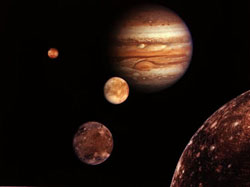 I'm interested in what this data tells us about the kind of materials embedded into the objects that went into making the solid parts of these planets and their satellites. We see a lot of diversity in the way the satellites look. For example, we know that water is not only just a very important constituent, its ubiquitous and easy to track down. Other constituents, such as ammonia -- not so easy to find even though most of us expect that it is there. Jupiter System Montage (left): Image credit: NASA/JPL
I'm interested in what this data tells us about the kind of materials embedded into the objects that went into making the solid parts of these planets and their satellites. We see a lot of diversity in the way the satellites look. For example, we know that water is not only just a very important constituent, its ubiquitous and easy to track down. Other constituents, such as ammonia -- not so easy to find even though most of us expect that it is there. Jupiter System Montage (left): Image credit: NASA/JPL
Much of what I do is theoretical so I develop theoretical models. I take the data we see and construct a picture based on that data. If it's possible to relate what we see at Jupiter to what we see at Saturn or Uranus, I want to understand both the similarities and the differences.
What is one of the coolest things about your project?
The state of differentiation of Saturn's moon, Titan, is between that of Callisto and Ganymede. I'm working on developing a consistent thermal evolutionary model that could explain the formation process for Ganymede, Titan and Callisto. I'd like to show you can get their different states over the age of the solar system.
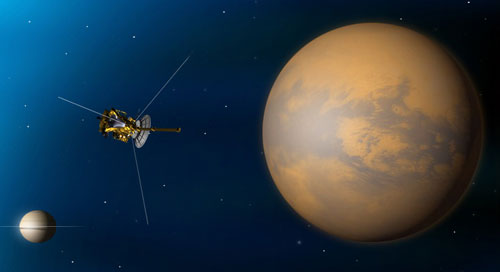
Cassini Gazes at Veiled Titan (rendering): Artist's concept of Cassini's Sept. 24, 2010, flyby of Saturn's moon Titan. Image credit: NASA/JPL-Caltech
But perhaps the coolest thing about my projects in general is having actual data -- it's tangible. You can access the data from which you can draw these conclusions. It's almost like being there and taking a sample.
What is one of the most interesting discoveries you've made about the compositional evolution of Saturn's rings?
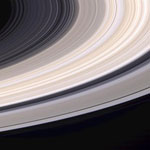 When I started working with Voyager data, my project involved looking at the rings and coming up with models to try and explain their composition. One of the most interesting things about the rings is they're made up almost entirely of ice. However, for anyone who has ever seen a true color picture of the rings, they certainly do not look like pure ice. It turns out it takes very little impurity, less than a fraction of a percent of material, to give the rings their distinct color. Ringscape in color (left:) Image credit: NASA/JPL/Space Science Institute
When I started working with Voyager data, my project involved looking at the rings and coming up with models to try and explain their composition. One of the most interesting things about the rings is they're made up almost entirely of ice. However, for anyone who has ever seen a true color picture of the rings, they certainly do not look like pure ice. It turns out it takes very little impurity, less than a fraction of a percent of material, to give the rings their distinct color. Ringscape in color (left:) Image credit: NASA/JPL/Space Science Institute
The model was based on the idea that because the rings' surface area is so huge, they are much more susceptible to micro-meteorite bombardment. Even now, there are lots of dust particles floating around in the outer solar system which pass with some regularity through the planetary systems. These dust grains impact on the satellites as well, but because the rings' surface area to mass ratio is so huge relative to a moon of the same mass, the dust actually makes a significant difference over time. Thus, micrometeorite bombardment is an extremely important piece of the rings' evolutionary puzzle because these impurities cause them to darken over time. The impacts also lead to structural changes in the rings because material gets thrown around from one ring region to another. Most of the dust particles impacting on the rings are thought to be mostly neutral and dark in color, similar to cometary dust (e.g. Haley's Comet).
Majestic Saturn, in the Infrared This false-color composite image, constructed from data obtained by NASA's Cassini spacecraft, shows Saturn's rings and southern hemisphere. The composite image was made from 65 individual observations by Cassini's visual and infrared mapping spectrometer in the near-infrared portion of the light spectrum on Nov. 1, 2008. The observations were each six minutes long. Image credit: NASA/JPL/University of Arizona
If you have an idea of what the impact rate of this dusty material is, you can simulate the evolution of the rings over time and extrapolate how long it would take to start from some initial condition involving just ice and a very small fraction of some initially unknown native, spectrally absorbing material and get the coloring that we now see. From that, we can extract information about the materials that gives the rings their characteristic color.
What do you currently consider your biggest challenge?
Funding is always a difficult process. Getting people to accept your ideas can also be a challenge. Inevitably if you're working on a problem that is important in the field, there is going to be a lot of competition for grants. In this field, people can be married to their ideas and it's hard to convince people if you have a different idea.
Why should the general public care about your research? In your opinion, what is the potential impact?
That's a difficult question to answer. There is value in pure science and research. For anyone interested in furthering the general collective knowledge of humanity, we need to know how planetary objects were formed. Once we know that, we can predict how objects in other planetary systems were formed. At some point, the answers we discover now may prove even more valuable for future research and explorations.
What motivates you?
Solving the mystery. Creating models that lead to solutions and results keeps my interest high. It may not be the final answer but it's an answer that takes us in the right direction. Science is a building process and we keep building on what was discovered years ago.
With the rapid rate of technological advancements, can the answers you're seeking be found in the next 20 years or so?
I think we can get closer to the answers. It could be that we substantiate that someone was right a long time ago but didn't have the means to model it. Obviously with technology, the ability to do things has improved but there are always more problems and they tend to increase in complexity. Qualitatively, we're always getting closer to the answers; we're probably not far off.
I'm trying to advance current knowledge significantly. Generally when you try to do this, you inevitably run into a lot of scrutiny. If you try to move in a certain direction that is quite different than someone else who has been working on the same problem for a decade, you're going to run into resistance and that's just the nature of the field. You have to be tough skinned to blaze new trails.
The Birth of Stars This new Hubble photo is but a small portion of one of the largest seen star-birth regions in the galaxy, the Carina Nebula. Towers of cool hydrogen laced with dust rise from the wall of the nebula. Image Credit: NASA, ESA, and M. Livio and the Hubble 20th Anniversary Team (STScI)
What historic personality do you admire most and why?
I admire people who espouse or inspire free thought. I always admire people, and especially the people in the past, who were willing to go against the establishment because they believed in what they were doing. People like Darwin, Galileo or Copernicus did serious research, reasoned things out in their head, and certainly in the case of Darwin, struggled with it for years before finally going public with his theories. I admire that those men challenged current thinking in a time when it was very dangerous to do so.
What was your dream job as a child?
When I think back on my youth, a love of science and astronomy was always a constant. I went through a stage where I wanted to be an astronaut; but as a kid, I wanted to be the astronaut who was traveling to other planets. Once I got old enough, I realized that was not the reality. Other interests would come and go, but astronomy was the one constant, so in a sense, I'm doing what I always wanted to do.
What is your philosophy of life?
My philosophy is to enjoy my work and what I have in my life as best I can.
Is there someone you would like to swap roles with for a day?
Strangely, I've thought about swapping roles with the President of the United States for just a day. I'm sure he has this really structured day, which is, of course, the total antithesis of my day, and he deals with so many different pressures. It must be so hectic. It would be interesting to see what it's like, especially with our current president.
If time wasn't an issue, what would you still like to learn?
I'm always interested in learning other languages. I speak Spanish and continuously trying to improve my Japanese, but learning Chinese might be practical. It would also be interesting to learn more about the medical field and become a doctor or a medical researcher. Another frontier, of course, is the ocean and there is so much that is interesting to study there as well.
* Learn more about Paul and his fascinating research in his full interview.
